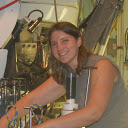 |
August 13, 2014Dr. Julie Meyer, University of FloridaMicrobial life in cold, hydrologically active oceanic crustal fluids at North Pond |
Abstract
The cold, basalt-hosted, oceanic crustal aquifer is one of the largest ecosystems on Earth, yet little is known about its indigenous microorganisms. Seawater enters the aquifer through porous, exposed basaltic rocks in the upper layers of young oceanic crust, circulates underneath sedimented seafloor and is later discharged in other regions of exposed basaltic crust. During its residence beneath the ocean floor, seawater undergoes both biotic and abiotic transformations that may impact global biogeochemical cycles. Recently installed subseafloor observatories on the western flank of the Mid-Atlantic Ridge penetrate hundreds of meters into the crust and provide an unprecedented opportunity to investigate microbial life in this understudied realm. I will present our findings from the initial microbiological and geochemical characterization of low-temperature basaltic formation fluids, as the first is a series of related studies documenting the progression of borehole equilibration. Our results reveal an active and diverse bacterial community in the crustal aquifer engaged in both heterotrophy and autotrophy.
Speaker Biography
Dr. Meyer was a C-DEBI Postdoctoral Fellow in the lab of Dr. Julie Huber from 2011-2013, investigating formation fluids from North Pond. She is now a postdoctoral scientist at the University of Florida, working to uncover microbial community dynamics and microbe-microbe interactions in the establishment of coral diseases. Overall, her research interests focus on the role of microbial genomic variation in marine ecosystem functioning and how microbial genomes reflect adaptation to environmental niches.

